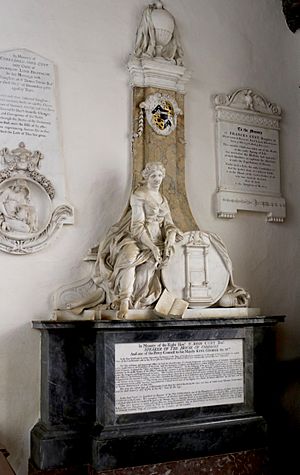William Tyler (architect) facts for kids
William Tyler (born April 18, 1728, died September 6, 1801) was a talented English artist. He worked as a sculptor, a landscaper, and an architect. He was also one of the three people who helped start the Royal Academy in 1768. This was a very important art group. He also led another group called the Society of Artists.
Contents
Early Life and Training
William Tyler went to Westminster School when he was young. After school, he studied for several years with a famous sculptor named Louis François Roubiliac. Roubiliac had moved to London in 1732. Tyler got married in 1750 when he was 22 years old. He is believed to have lived in Dean Street at first.
What Kind of Sculptures Did Tyler Make?
William Tyler had his office in Vine Street, London, from 1763 to 1784. In 1768, he was one of three sculptors who helped create the Royal Academy. The other two were Joseph Wilton and Agostino Carlini. Tyler was one of the first 40 members of this new academy. He also helped check their financial records.
As a sculptor, Tyler created many monuments. These are like large sculptures or structures built to remember important people. For example, he made a monument for George Lee, 3rd Earl of Lichfield in Spelsbury, Oxfordshire. He also made one for Sir John Cust, 3rd Baronet of Stamford in 1770. Sir John Cust was the Speaker of the House of Commons.
Tyler also worked with one of his students, Robert Ashton. Together, they created a monument for a scholar named Dr. Martin Folkes.
Famous Sculpture Projects
Tyler created many important sculptures. Here are some examples:
- A monument with a bust (a sculpture of someone's head and shoulders) for Joseph Smith at Queen's College, Oxford (1756).
- A monument for Francis Gastrell in Oxford Cathedral (1761).
- A monument with a bust for Samuel Vassall in King's Chapel, Boston in the USA (1766).
- A monument for Sir John Cust, 3rd Baronet in Belton church (1770).
- A monument for George Lee, 3rd Earl of Lichfield in Spelsbury Parish Church (1772).
- A monument for the actor Barton Booth in Westminster Abbey (1772).
- A monument for Dr. Zachary Pearce in Westminster Abbey (1774).
- A monument for General Stringer Lawrence in Westminster Abbey (1775).
- A monument for General William Amherst in Sevenoaks, Kent (1781).
What Buildings Did Tyler Design?
In the late 1700s, William Tyler also worked as an architect. This means he designed buildings. Some of his designs included:
- Part of London's Freemasons' Hall (1776). He worked on this with Thomas Sandby.
- The Ordnance office in Westminster (1779–80). This building was later taken down in 1805.
- The Villa Maria in Kensington (around 1800). This house was later called Gloucester Lodge. The Duke of Gloucester asked Tyler to design it for his wife. Later, a Prime Minister named George Canning lived there.
- Bridport Town Hall in Dorset (1786).
- Dorset County Gaol (a prison) in Dorchester (around 1795).
Tyler's Role in the Royal Academy
Tyler was one of the first members of the Royal Academy when it started in 1768. Even though he was nominated as an architect, he often showed his busts and low relief sculptures at their exhibitions. A low relief is a type of sculpture that is carved so it sticks out only a little from a flat surface.
He showed his art at the Royal Academy from 1769 to 1800. His first piece was a marble sculpture of an "Indian" person. It showed North America offering its products to Britannia (a symbol of Britain). Later, he also showed some of his architectural drawings. These included designs for a "Garden front of a villa" (1782) and the Bridport Town Hall (1789).
Tyler played an important part in a disagreement with Sir Joshua Reynolds, who was the first president of the Royal Academy. This argument was about Reynolds trying to get Joseph Bonomi elected as a full member. The dispute even caused Reynolds to temporarily leave the academy in 1790.
In 1795, Tyler and George Dance were asked to check the academy's money records. The next year, Tyler and Dance became the Royal Academy's first official auditors. They helped make sure the academy's money was managed well. Because of their hard work, Tyler was given a silver cup in 1799.
William Tyler passed away at his home in Caroline Street, Bedford Square, on September 6, 1801.
Images for kids



